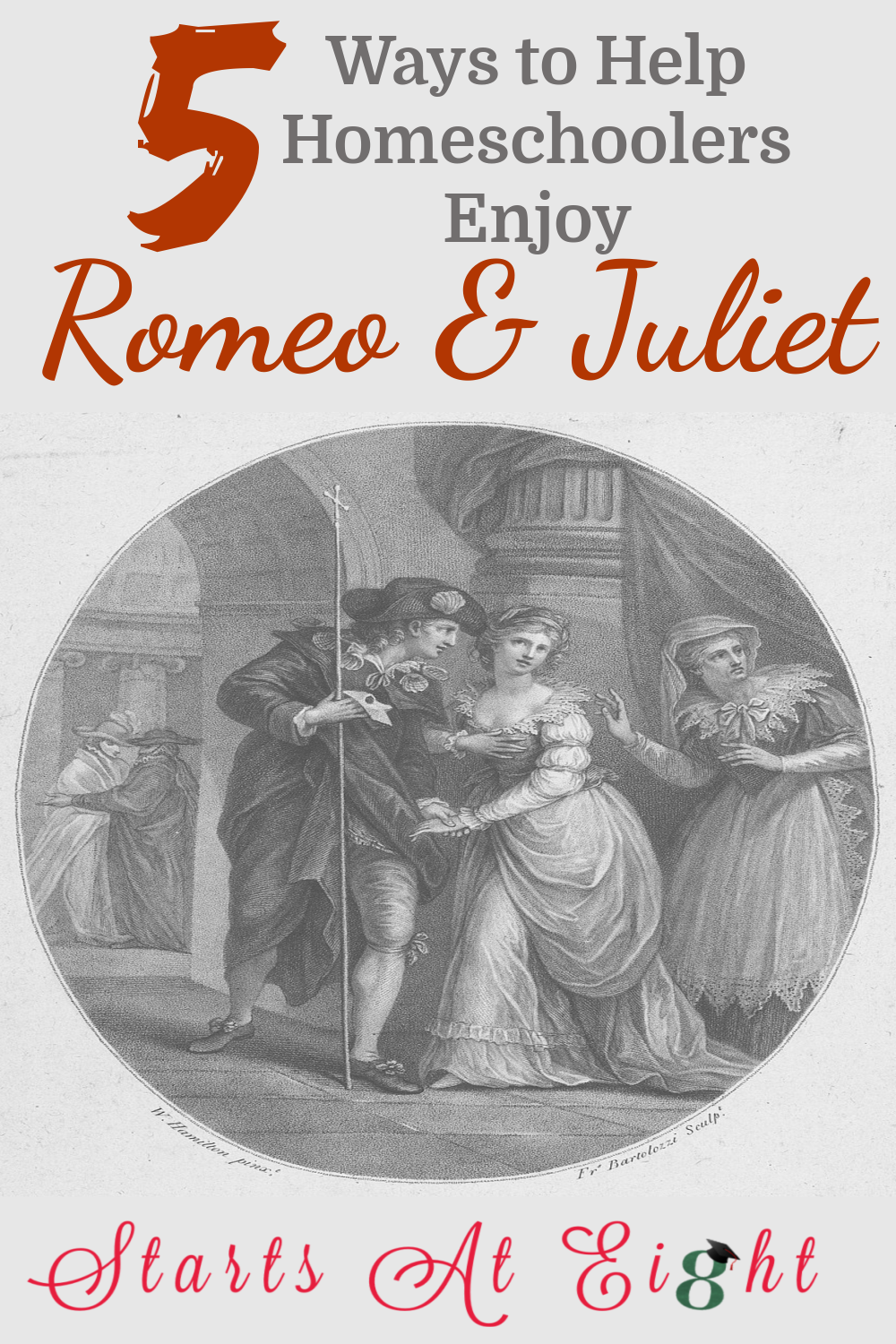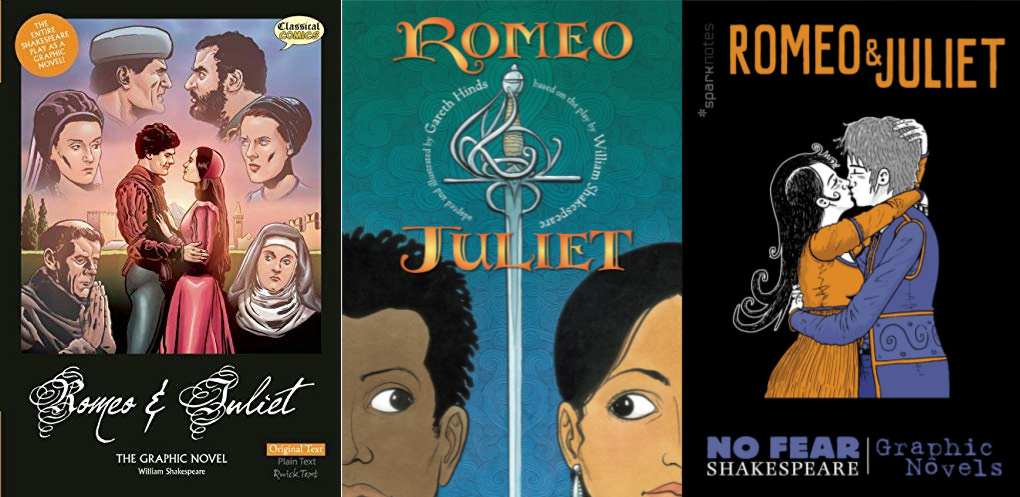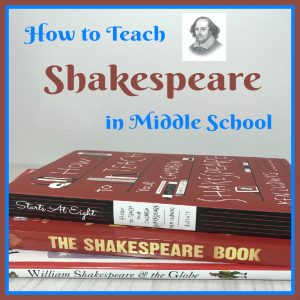5 Ways to Help Homeschoolers Enjoy Romeo and Juliet
Tackling Shakespeare’s plays, such as Romeo and Juliet and be quite intimidating. Here are some strategies and tips to help your kids gain a better understanding of Romeo and Juliet. {Hint: These suggestions can also be used when tackling other Shakespearean works as well!}

The Bard of Avon wrote some of the most influential plays and poetry in the history of English literature. Four hundred years after his death, he is hailed as the epitome of Western literature and his works – read and enjoyed by everyone who considers themselves part of the cultured elite.
Romeo and Juliet, the tale of the star-crossed couple who defied their families for love, is Shakespeare’s most famous play. It has everything – drama, deep moral questions, memorable characters, witty humor, bawdy humor, intricate wordplay, poetry – you name it. It has kept up with the times, primarily because it is based on themes that are universal and relevant even today. And at the heart of Romeo and Juliet, like every Shakespearean play, are ideas that everyone is familiar with, if not relate to – love, infatuation, marriage, revenge, suicide, and death.
And yet, reading Romeo and Juliet can be a challenge, especially for people who are taught at home. Shakespeare is intimidating to the 21st century homeschooler because his language (early Modern English) is unfamiliar, his grammar old-fashioned, and his plots convoluted and hard-to-follow.
The Five-Part Strategy for Tackling Romeo and Juliet
1. Piquing learners’ interest from the get-go
There are several ways to make homeschoolers’ first brush with the Bard an exciting one. Romeo and Juliet has been interpreted countless times by filmmakers. There are plenty of movies based on Romeo and Juliet; learners can take their pick. Watching the cinematic version of the play will leave them wanting to know more, which is always a good start.
Movie Adaptations of Romeo and Juliet:

- Romeo and Juliet 1968 – starring Leonard Whiting, Olivia Hussey, and John McEnery
- Romeo + Julie 1996 – Starring Leonardo Dicaprio, Claire Danes, and Brian Dennehy
- Romeo and Juliet 2015 – Starring Orlando Bloom, Condola Rashad, and Donte Bonner
2. Start with a graphic novel
Graphic novels are popular because pictures can be universally understood. Regardless of their level or the type of text they are reading, homeschoolers might do well with the help of graphic novels. While this strategy works wonders, Shakespearean language can still be challenging until learners familiarize themselves with antiquated early Modern English terms like “thine,” “thou,” “hast,” “gast,” “knave”. Here are some tips to make graphic novels more effective:
- Before starting on a new scene, learners can look at the pictures and the text and talk about what they think is happening.
- Once they start reading, they can identify words in the text that support their conjectures.
- They could also summarize what they think is happening in the pictures without looking at the text.
These exercises also give them a chance to use their newly-acquired vocabulary in writing or speaking.
Here are some Graphic Novels to Choose From:

- Romeo and Juliet: The Graphic Novel – Script adaptation by John McDonald (This is a Free PDF Version) There is also a paperback option)
- Romeo & Juliet (Shakespeare Classics Graphic Novels)
- Romeo and Juliet (No Fear Shakespeare Graphic Novels
3. Discussing Shakespearean themes to promote critical thinking
Romeo and Juliet is packed with themes that appeal to young people – love, infatuation, suicide, individuals vs. society, family and duty, violence, the generation gap, etc. Before starting on Romeo and Juliet, homeschoolers might benefit from having lessons that center around its major themes. The lessons could also focus on the differences between what their culture teaches them and how they personally feel. At the end of the reading, learners could have a discussion with their tutors about whether they agree or disagree with the actions of the main characters. This can help them develop and enhance their critical thinking abilities, which are vital for problem-solving in everyday life.
4. Watching it/acting it
Plays are meant to be watched or performed, not to be read in silence. Once homeschoolers have watched the movie, they are more likely to feel inspired to perform the play. They could enact scenes with their tutors, which might even make them realize that they enjoy acting. This exercise also helps parents identify if their kids have a flair for the dramatics, so they can nurture it further by getting them enrolled in children’s improv or theater groups.
5. Using a contemporary-English version along with the original text
When the linguistic complexities of 16th century English prove to be too much for their homeschoolers, many tutors turn to websites that present readers with contemporary translations of Romeo and Juliet set alongside the original text. This makes key speeches and dialogues far more accessible to learners and is one of the best ways to banish blank and uncomprehending faces often encountered while teaching at home. Another great option is the No Fear Shakespeare Series for which they have Romeo and Juliet. Each No Fear guide contains:
- The complete text of the original play
- A line-by-line translation that puts the words into everyday language
- A complete list of characters, with descriptions
- Plenty of helpful commentary
Using these five strategies, homeschoolers will find it easier to comprehend and articulate the interesting ideas they encounter in Romeo and Juliet, exchange opinions about the play, and develop new, robust vocabulary.
Bonus: SparkNotes and CrashCourse
More Help with Shakespeare



Author Bio:
Sophia is an online ESL/EFL instructor and a passionate educator. She found her true calling — teaching — while she was juggling writing and a 9-5 desk job. When she is not busy earning a living, she volunteers as a social worker. Her active online presence demonstrates her strong belief in the power of networking. If you want to connect, you can find her on Facebook, Twitter, and her blog Essay Writing and More.





